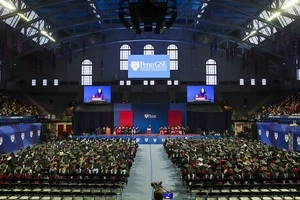Faculty Expert
-
Diana Wildermuth
Lecturer in Educational Practice
Human Development and Quantitative Methods Division
Your child may dream about playing sports in college if they are a standout athlete, but there’s a long road from high school to collegiate sports. To get there, your student-athlete needs to balance their sports and academics. As parents and caregivers, you can help them navigate the process and provide critical guidance and support.
The number of student-athletes and sports are at an all-time high. According to a recent NCAA report, nearly 530,000 college students participated in 28 men's and 31 women’s sports in 2022. So while there are ample opportunities to keep playing sports in college, the journey will look different for every athlete and their family.
The college recruiting process is complicated and varies widely by sport. To best prepare, start talking to your child, their coaches, and school advisors when they start high school and tap into resources online and in your sports community.
If it feels overwhelming, don’t panic. Here are pointers to help navigate the recruiting process and find success in college.
Have honest conversations
Many athletes aspire to play in college, but not everyone can play for a Power 5 conference team. There are varying levels of competition at the Division I, II, and III levels. As an alternative, many schools also offer club sports teams. To ascertain your child’s prospects, talk to their school or travel team coaches and get their input.
It’s also essential to ask your child about their goals for their sport and overall college experience. Some students want a large public university in a college town, while others want a small campus or an urban setting. Those preferences impact the schools you target for recruiting.
Learn the process and the rules
The college recruiting process differs by sport and if the program is Division I, II, or III. Division I and II schools tend to be larger institutions, while Division III schools are typically smaller schools. Division I and Division II schools can offer athletic scholarships, while Division III schools do not, but may offer more academic scholarships. Some schools even offer a mix of sports across the three divisions.
The NCAA manages the recruiting process, which has strict rules for when coaches can talk to athletes, visits, and when students can commit to play at a school. The NCAA also has different academic requirements, and some schools have rules. To navigate the tangled web, dig into the NCAA’s website. It provides extensive resources, including the timeline for recruiting, calendars, and regulations by type of school and sport.
Find a support system
In parenting, it always helps to have a village. To gather information on recruiting and specific programs, seek parents of older athletes for advice and insights on their student-athlete experience. Also, ask your student’s coaches and school counselors for their input. They know your child’s athletic and academic skills best.
The web is full of great resources, too. On Facebook, there are parent groups for nearly every sport imaginable. Sports-specific groups, like USA Soccer or USA Lacrosse, offer helpful guides online and may provide helpful information sessions.
Focus on academics
They’re called “student-athletes” for a reason. While your child practices and competes, they also need to focus on schoolwork. To qualify to play in college, they may need to take particular classes and maintain a minimum grade point average. For specifics, check the NCAA guide and individual schools, as requirements vary by institution and state.
Once your child gets on campus, they’ll juggle academics with practices, team meetings, travel, and games. As you speak to coaches, ask how they support athletes academically, including offering tutors and required study sessions.
Think about finances
Only a handful of athletes earn a “free ride” to play sports in college. Most women’s and men’s Division I and Division II programs have limited scholarships per sport. Division III schools and Ivy League Conference schools don’t offer athletic scholarships but may assist with finding other aid. Schools sometimes help athletes arrange alternative financial assistance, such as merit scholarships or grants. Even if your student gets financial support, it may not cover all expenses.
It’s important to discuss what your family can afford and whether you want to take out federal financial aid or private loans.
The bottom line: Enjoy the ride
After a lifetime of driving your child to practice and washing uniforms, your role as a sports parent is changing. So savor every moment of watching them play the game they love and your sports community. Maybe next season, you’ll be cheering for their college team.

Diana Wildermuth, Ph.D., NCC, LPC, CCTP, is a lecturer in educational practice at Penn GSE and a former high school counselor with extensive experience in collegiate sports recruiting.
Subscribe to the Educator's Playbook
Get the latest release of the Educator's Playbook delivered straight to your inbox.
Media Inquiries
Penn GSE Communications is here to help reporters connect with the education experts they need.










